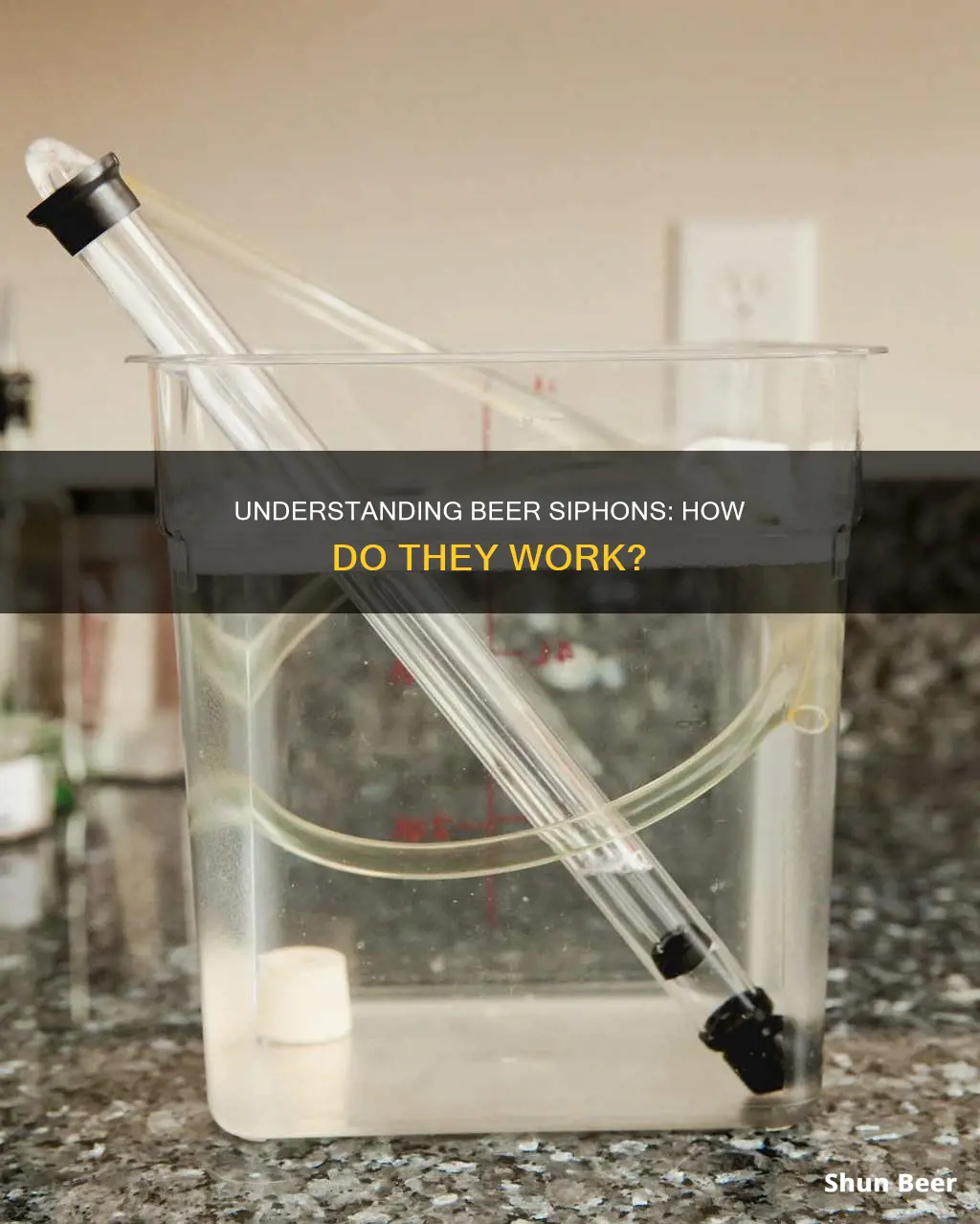
Homebrewers often use a siphon to transfer beer from one container to another, a process known as racking. This is done to avoid unwanted contamination or oxidation. There are several ways to start a siphon, but the safest way is to use the water or sanitizer method, where the siphon hose is filled with water or a sanitizer solution and then allowed to drain, drawing the beer behind it. This minimises the risk of contamination. An auto-siphon is a popular tool for this process, as it is easy to use and helps to avoid splashing and unwanted oxidation.
| Characteristics | Values |
|---|---|
| Purpose | To transfer beer from one container to another |
| Brewing Term | Racking |
| Process | Based on Bernoulli's principle; creating a difference in pressure between two containers and forcing liquid to flow from one to the other |
| Equipment | Hose and racking cane, sterile siphon starter, auto-siphon |
| Pros | Avoids contamination, oxidation, and mess |
| Cons | Tricky to initiate the siphon, prone to scratches and breakage, expensive |
What You'll Learn

Using a hose and racking cane
Sanitation and Setup:
Start by sanitising the racking cane, hose, and all other equipment that will come into contact with the beer. This step is crucial to prevent contamination and ensure the beer's quality. Place the source vessel (containing the beer) on an elevated surface, such as a counter or table, and position the empty destination vessel a few feet below. Ensure that the two containers are stable and secure.
Initiating the Siphon:
There are several methods to initiate the siphon with a racking cane and hose setup:
- Avoid Mouth Start: Directly sucking on the hose is straightforward but poses a high risk of contamination from bacteria in your mouth.
- Water or Sanitizer Start: Pre-fill the hose and racking cane with water or sanitiser, then allow it to drain. This method requires finesse but minimises the risk of contamination.
- Turkey Baster Method: Use a sanitised turkey baster to initiate the siphon. This method is easy and effective but requires additional equipment.
- One-Way Valve Method: If your racking cane has a one-way valve, submerge the closed end into the beer, place the free end of the hose into the destination vessel, and plunge the racking cane up and down. This method is simple but relies on the functionality of the one-way valve.
Transferring the Beer:
Once the siphon is initiated, ensure that the racking cane remains submerged in the beer and that the hose is securely connected to the racking cane and the destination vessel. Monitor the transfer process, keeping splashing to a minimum. Use a hose clamp to control the flow rate if needed.
Finishing Up:
When the beer has almost entirely transferred, you can optionally tip the original container to get the last remaining liquid. Remove the tubing from the destination vessel and proceed with any necessary steps, such as capping or inserting an airlock.
Understanding Beer Staffs: A Guide to Their Functionality
You may want to see also

Sterile siphon starters
A sterile siphon starter is a device that simplifies the process of transferring beer from one container to another. It is designed to create an airtight seal with an orange cap on a carboy, and by applying pressure through a sterile filter, the siphon starts effortlessly. This method eliminates the risk of contamination associated with traditional pouring methods and direct mouth contact.
The sterile siphon starter typically includes a 26-inch stainless racking cane, a red sediment reduction tip, a rubber carboy blowoff hood with white caps, 5 feet of 3/8" ID vinyl tubing, and a stainless hose clamp. The racking cane can be adjusted to the desired depth, just above the sediment level, to ensure that the beer is transferred without disturbing the sediment.
To use the sterile siphon starter, firmly push the carboy hood over the mouth of the carboy. Slide the racking cane to the desired depth and blow into the sterile filter for 2-3 seconds. This slight pressurization of the carboy forces the beer to flow up the racking cane and out through the tubing, starting the siphon. The sterile filter removes 99.98% of airborne bacteria, ensuring a sanitary transfer.
The sterile siphon starter is compatible with various carboy sizes, including 3, 5, 6, and 6.5-gallon smooth neck glass carboys, making it a versatile tool for homebrewers. It offers a simple, efficient, and contamination-free solution for transferring beer between containers.
Mouthwash Beer Spray: Effective Mosquito Repellent?
You may want to see also

AutoSiphons
An auto-siphon is a device used by homebrewers to transfer beer from one vessel to another. It is a simple yet effective tool that makes the siphoning process easier and more sanitary than traditional methods.
The auto-siphon consists of four main components: a large tube, a racking cane, a sediment blocking tip, and flexible siphon tubing. The large tube contains the smaller racking cane, which has a 90-degree bend at one end and a plunger at the other. The plunger creates a seal to block airflow and generate a vacuum. The racking cane fits inside a wider sleeve or racking tube, which has a filter to block unwanted particles. The sediment blocking tip is a small black cap that attaches to the bottom of the racking cane to prevent sediment flow during the transfer. Finally, the flexible siphon tubing attaches to the bent end of the racking cane, allowing the beer to flow into the new container.
To use an auto-siphon, the brewer must first ensure that the vessel they are transferring from is elevated above the destination container. This elevation is crucial to allow gravity to facilitate the transfer. Both the auto-siphon and the destination container should be thoroughly sanitised to prevent contamination. The racking cane is then lifted and plunged back down into the tube, creating a vacuum and initiating the flow of liquid. Once the flow starts, gravity takes over, and the beer is transferred smoothly and efficiently.
The auto-siphon is a valuable tool for homebrewers, offering a simple, sanitary, and reliable method for transferring beer. Its design minimises the risk of contamination and oxidation, ensuring the quality of the brew.
Beer Olympics: Competitive Drinking Games Explained
You may want to see also

Avoiding contamination
Firstly, avoid using your mouth to start the siphon. This is a common method, but it poses a high risk of contamination. Instead, use the water or sanitiser method, where you fill the siphon hose with water or a sanitiser solution and allow it to drain, drawing the beer behind it. This minimises the risk of contamination.
Another option is to use a mechanical device, such as an AutoSiphon, which is also recommended for beginners due to its ease of use and simplicity. It requires just a few pumps to initiate the siphon and is particularly useful for dealing with low liquid volumes.
To prevent contamination, ensure all your equipment is properly sanitised before use. Clean your equipment immediately after use with a suitable cleaner and sanitise it before each use. Store it in a dry, safe place to avoid damage and contamination.
When siphoning, try to keep splashing to a minimum. Keep the open end of the tubing submerged an inch or so under the surface of the transferred liquid.
Beer Slug Traps: Do They Work?
You may want to see also

Sanitation methods
Sanitation is a critical step in the beer-making process, as any contamination can ruin a batch. Before sanitizing, equipment must be cleaned thoroughly. This means removing all visible dirt and residue, but not necessarily living organisms.
Chemical Sanitizers
The most common way to sanitize brewing equipment is with chemical sanitizers. In the past, homebrewers often used a diluted solution of household bleach, but nowadays, modern chemical sanitizers are preferred. These typically fall into two categories: acid-based and iodine-based.
Acid-Based
Acid-based sanitizers use food-grade acids to kill wild bacteria and yeasts. The most popular product is Star San, which requires only a minute of contact time and no rinsing once the job is done. It also has a long shelf life, making it convenient for homebrewers.
Iodine-Based
Iodine-based sanitizers, such as Iodophor, are effective and require no rinsing. They are usually more affordable than acid-based products but can stain plastic equipment, which some brewers may find off-putting.
Heat Sanitation
Heat is another method to sanitize equipment, though it is less commonly used than chemical sanitizers. Certain types of equipment are more amenable to heat sanitation than others.
Boiling
Boiling water for a couple of minutes is an effective way to kill any microorganisms on the surface of equipment. This method is suitable for items made of glass and metal, such as immersion wort chillers, stainless steel diffusion stones, and borosilicate flasks.
Oven
Using an oven to heat-sanitize bottles is effective, but it requires extra time due to the need for slow heating and cooling. The stress of temperature changes can weaken the bottles over time.
Dishwasher
A dishwasher with a sanitation cycle can be used for glass or metal gear. It is important to run it without detergent on the hottest cycle and use the hottest drying setting. However, this method is not recommended for cleaning, as dishwasher detergent can cause head-retention problems.
Other Methods
In addition to the above methods, there are a few other techniques worth mentioning:
Soaking and Scrubbing
This involves using a cleaning solution and either scrubbing the equipment or letting it soak to remove residue. This method requires more time and effort but ensures a thorough clean.
Auto-Siphon
The auto-siphon is a piece of equipment that simplifies the racking process and reduces the risk of contamination. It utilizes atmospheric pressure and gravity to transfer liquid without the need for "old-school" methods like sucking on one end, which can introduce bacteria.
General Tips
- Always sanitize your equipment before each use and clean it immediately after use.
- Store equipment in a dry, safe place to avoid damage and contamination.
- Avoid using your mouth to start a siphon, as this can lead to contamination. Instead, use methods like the water/sanitizer start or mechanical devices like an AutoSiphon.
- Choose the right siphoning method for your specific requirements, budget, and preferences.
Do Beer Cozies Work? The Science Behind It
You may want to see also
Frequently asked questions
The safest way to start a beer siphon is by using the water or sanitizer method. First, pre-fill the hose with water or a sanitizer solution. Then, place the hose in the beer and allow the solution to flow out, drawing the beer behind it. This method minimises the risk of contamination.
Beer siphons are used to transfer beer from one container to another without introducing too much oxygen into the system, transferring a lot of sediment, or making a mess. This process is known as "racking".
A beer siphon works by creating a difference in pressure between two containers. By forcing liquid to flow from one container to another, the liquid will continue flowing as long as the pressure remains and there is liquid to pump.







